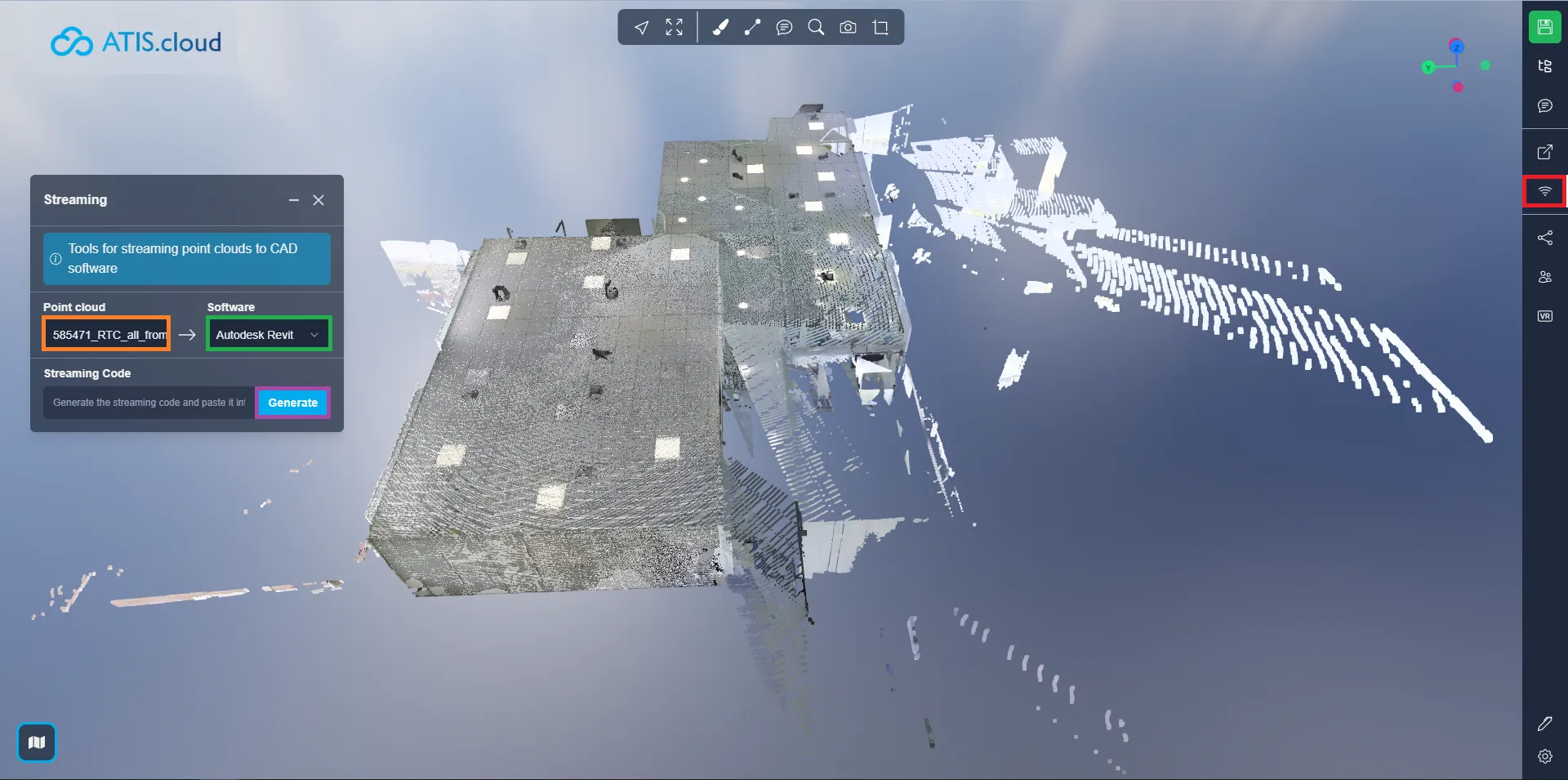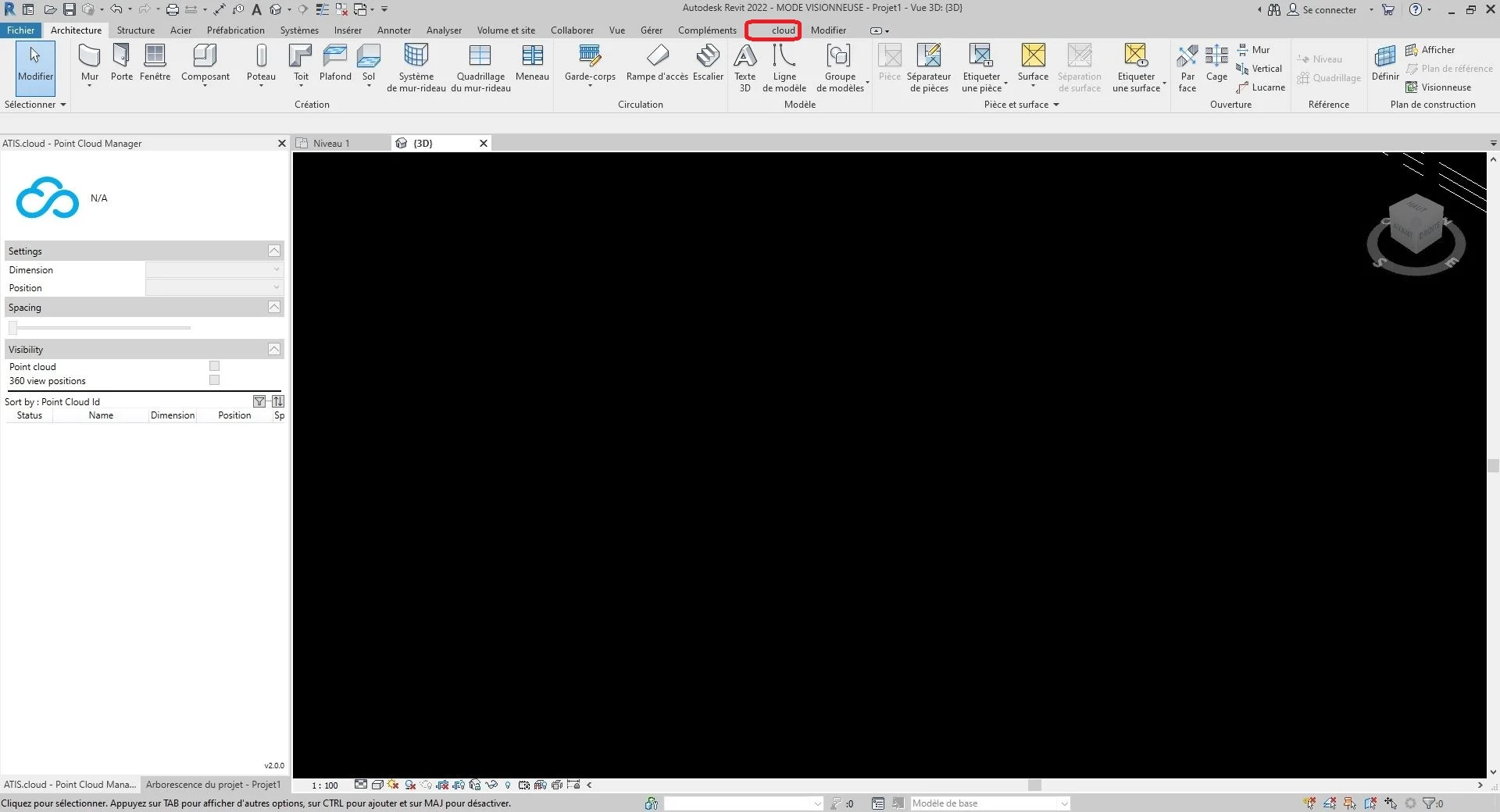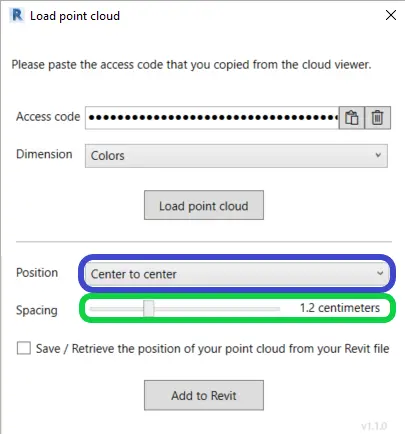If the Revit plugin is not installed on your computer, you can first go to the article “ Autodesk REVIT Plug-in - Installation ” and then come back here after this operation.
Please note that with these plugins you can serve any point cloud on the platform. First, open a project from the main menu by clicking on the project image. If no project is available, go to the “ Create a project ” article.
After opening a project, click on the streaming button, this will open the linked window. Then choose the cloud you want to use and verify that the selected software is Autodesk REVIT then click Generate.

To copy the code, click the Copy button.

Then open Autodesk REVIT with the previously added plugin. If it is not yet added, go to the “ Revit plugin installation” category.
In your Revit project, click on “cloud” in the toolbar located at the top.

Click on “cloud streamer” located in the “Add Point Cloud” category in the toolbar at the top of the screen.

Following this action, a dialog box appeared on the screen, click on the notepad icon to the right of the trash can button.
For information, the code generated from the site named “streaming code” corresponds to the “Access code” field on Revit. In addition, you can delete this field at any time by clicking on the delete button symbolized by a trash can.

You can then configure the dimension of the point cloud. The dimension is the type of display it will have.
For information, all the point cloud settings can be modified even after the addition thanks to the “ Point Cloud Manager ”.
There are currently five compatible dimension types.
- Colors : It is used to represent the color of each point in the point cloud. The red, green, and blue channels are used to represent the color of the dot, while the alpha channel is used to represent the transparency or opacity of the dot. The use of color in LiDAR point clouds can be useful for visualization and interpretation purposes, as it can provide additional information about the properties of the objects and surfaces represented by the points. For example, in vegetation mapping, the color of the points can be used to distinguish between different types of vegetation or to identify areas with high or low vegetation density.
- Intensity : It represents the strength or amplitude of the signal that was received by a sensor or device when the point was captured. In some cases, the intensity is related to the reflectance of the object at that point. For example, in a LiDAR point cloud, the intensity value represents the amount of laser light that has been reflected back to the sensor by the object. In this case, a higher Intensity value would indicate a surface that reflects more light, such as a white wall, while a lower Intensity value would indicate a surface that reflects less light, such as a black car. In other cases, the intensity may represent a different physical quantity. For example, in a photographic point cloud, intensity can represent the brightness of a pixel in the original image that was used to generate the point cloud.
- Classification : Will only work with compatible point clouds . The purpose of classification is to group similar points into meaningful categories, such as soil, vegetation, buildings, and other objects.
- Height : It represents the height or vertical position of each point. Elevation data is important in many point cloud applications, such as topographic mapping, flood modeling, urban planning, and infrastructure design.
- Point Source ID : This identifies the specific laser sensor that generated the point. Each laser sensor in a LiDAR system has a unique identifier or number, and this information is recorded in the point cloud data to enable analysis and quality control. Point source identification is especially useful in situations where multiple LiDAR sensors are used to capture a single scene or area. By identifying which sensor generated each point, it is possible to perform quality checks on the data and ensure that the data is correctly aligned and registered between the different sensors. This is especially important in applications such as forestry, where multiple LiDAR sensors can be used to capture data from different angles and perspectives. On our platform, the point source id is used to store the source analysis id, allowing users to easily track which analysis each point in the point cloud originated from. For example, if multiple scans were performed on the same area using a 3D laser scanner, each scan could be assigned a unique scan ID and the point source ID attribute for each point in the cloud points could be set to the corresponding scan ID.
To select the desired dimension, click in the selection rectangle to the right of the text “Dimension”.

Click "Load Point Cloud" to initialize the point cloud data.

Change the insert settings in Revit to your preference. You can adjust the spacing between points with the "Spacing" slider and choose the position of the point cloud in the project by selecting one of three options: "Center to Center", "Internal Origin", or "At the Shared Site".
- Center to Center : This option places the point cloud using the center of the viewport as a reference point.
- Internal origin : This option positions the point cloud using the internal origin of the cloud as a reference point. The internal origin is usually defined by the coordinate system of the point cloud itself. Using this option, the point cloud will be positioned according to its internal origin rather than the origin of the Revit project. This can be useful when you need to align the point cloud to its own internal coordinate system.
- At the shared site : This option places the point cloud at the location of the shared site. Shared site refers to a common geographic location on which multiple projects can be based. Using this option, the point cloud will be positioned according to the coordinates of the shared site. This can be useful when working on projects based on a common site and want to align the point cloud to that shared location.
- Auto – Origin to Last Placed : Revit places the next imported point cloud consistently with the previously imported point cloud. This option becomes activated after inserting a first point cloud. You can move this first cloud, for example, in order to align it correctly with the elements of the model. If you have additional point clouds created on the same site and in the same coordinate system as the first one, it is recommended to use this option to insert the additional point clouds. The new point clouds will then be correctly positioned relative to the first.

Once the configuration is complete, click "Add to Revit" to insert the point cloud into Revit.

Stop or Start point streaming:
In the toolbar, in the “Action” category, you have two buttons that allow you to either start point streaming or stop it.

Point streaming is a feature that allows points to arrive from the cloud little by little according to a certain organization. However, this operation requires a permanent internet connection and requires certain resources from the host machine.
This is why you can stop by clicking on “Stop streaming” or restart by clicking on “Start streaming” the point streaming.
Clear storage space:
The plugin may experience operational issues if your computer's disk space becomes full. That's why, in the "Settings" button located in the "cloud" menu bar under the "Settings" category, you can clear the storage space reserved for the Revit plugin. First, click on "Settings"

For information, the clouds will visually disappear from Revit, this is normal when you start the point streaming, the point clouds will reappear (go to the Stop or Start the point streaming section to start the point streaming).
Congratulation ! You have now inserted a point cloud into Revit from the streamed data.
For more information on managing point cloud settings, see the "Point Cloud Manager" category.
From this window, you can also specify the maximum value of GPU memory to be used and the maximum value of disk space not to be exceeded by the plugin.
To learn more about adding web project sources in Revit, please see the "Add Sources" category.
If you run into any issues, our support team is here to help. Happy exploring!